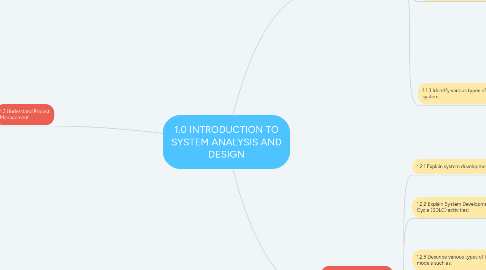
1. 1.1 Discuss Information System.
1.1. 1.1.1 Define information and information system.
1.1.1. Information : Is data that has been transformed into output that is valuable to users.
1.1.2. Information system : Combines information technology, people and data to support business requirements.
1.2. 1.1.2 Describe information system components.
1.2.1. Hardware : Is the physical layer of the information system
1.2.2. Software : System software Application software Enterprise applications
1.2.3. Data : Tables store data Linked tables work together to supply data
1.2.4. Processes : Describe the tasks and business functions that users, managers, and IT staff members perform to achieve specific results
1.2.5. Data : Stakeholders Users, or end users
1.3. 1.1.3 Identify various types of information system.
1.3.1. Transaction Processing Systems
1.3.2. Management Information Systems
1.3.3. Decision Support Systems
2. 1.2.4 Identify appropriate life cycle models based on given scenario
2.1. 1.2.1 Explain system development method:
2.1.1. a. Structured Analysis b. Object Oriented Analysis c. Agile/Adaptive Method
2.2. 1.2.2 Explain System Development Life Cycle (SDLC) activities:
2.2.1. a. Planning b. Analyze c. Design d. Development e. Testing f. Implementation g. Maintenance
2.3. 1.2.3 Describe various types of life cycle models such as:
2.3.1. a. Waterfall model b. Spiral Model c. Iterative and incremental development d. Agile Model e. Prototyping model f. Rapid Application Development (RAD) g. Joint Application Development (JAD)
2.4. 1.2.4 Identify appropriate life cycle models based on given scenario
2.4.1. 1.2.4 Identify appropriate life cycle models based on given scenario
2.5. 1.2.5 Describe project management activities:
2.5.1. a. planning b. scheduling c. monitoring d. reporting

